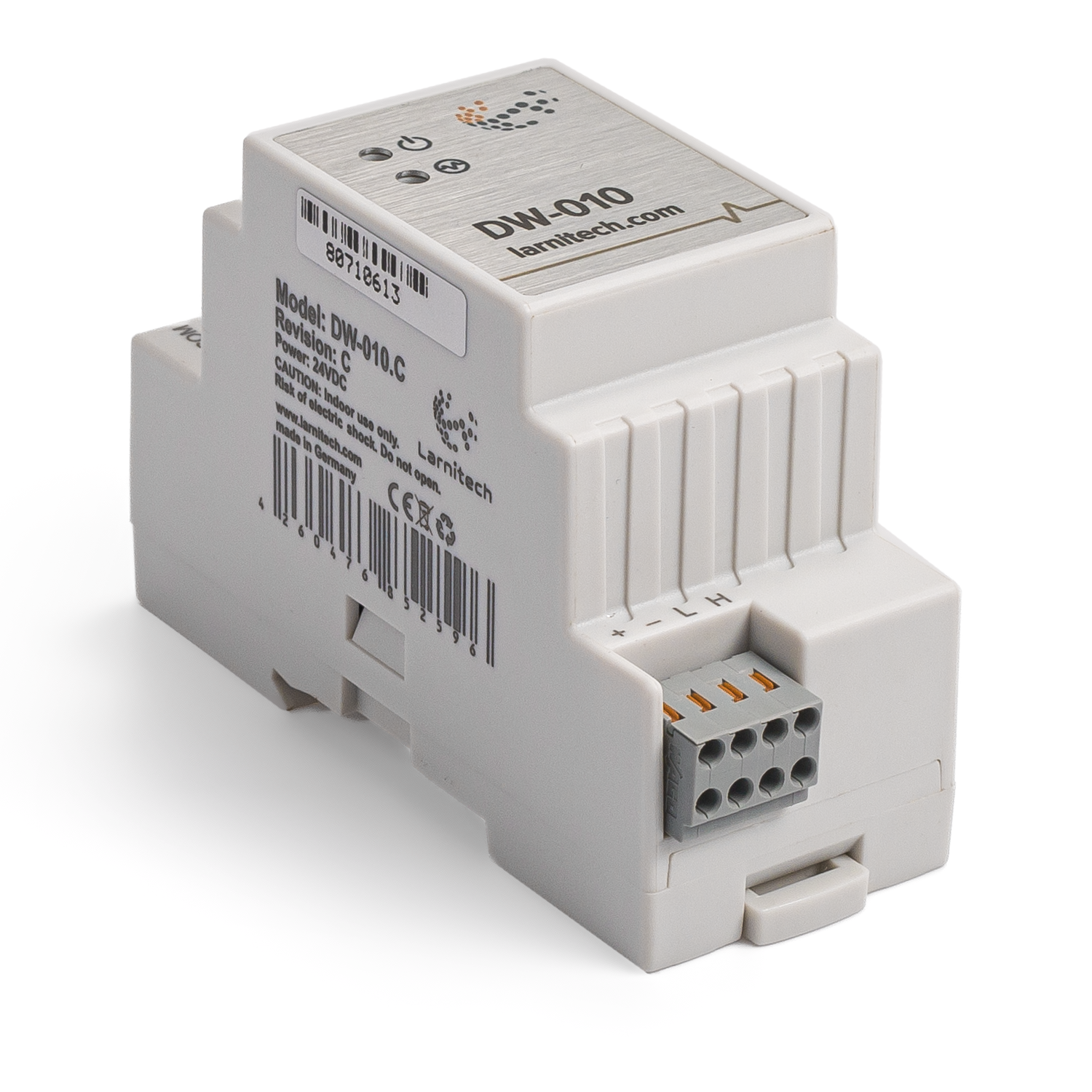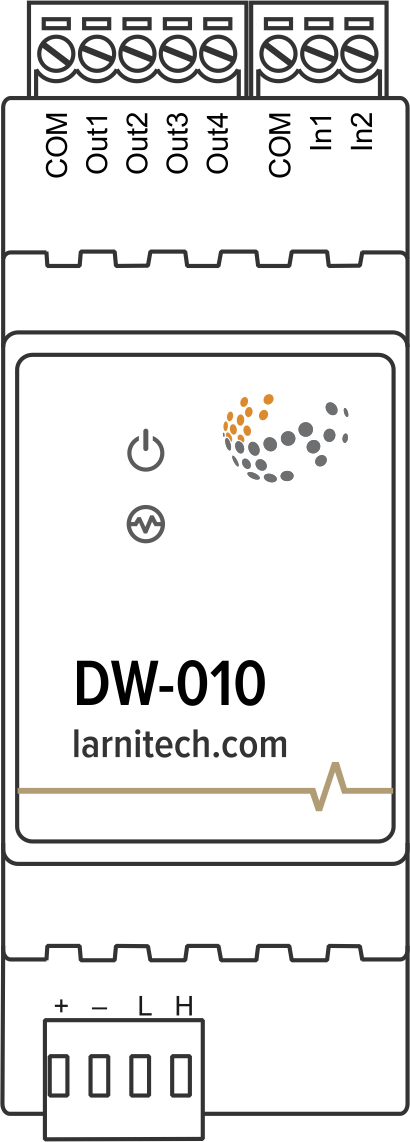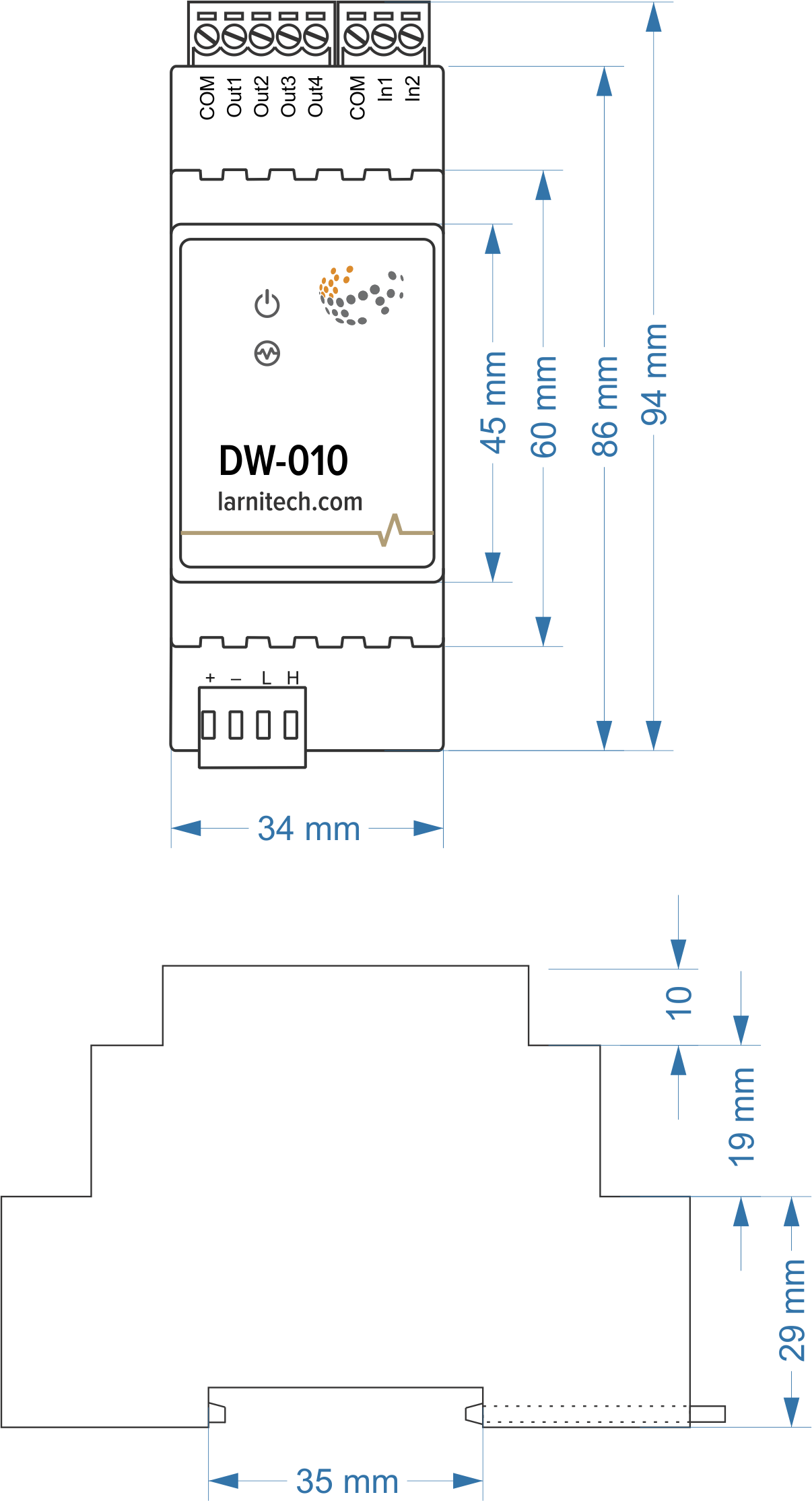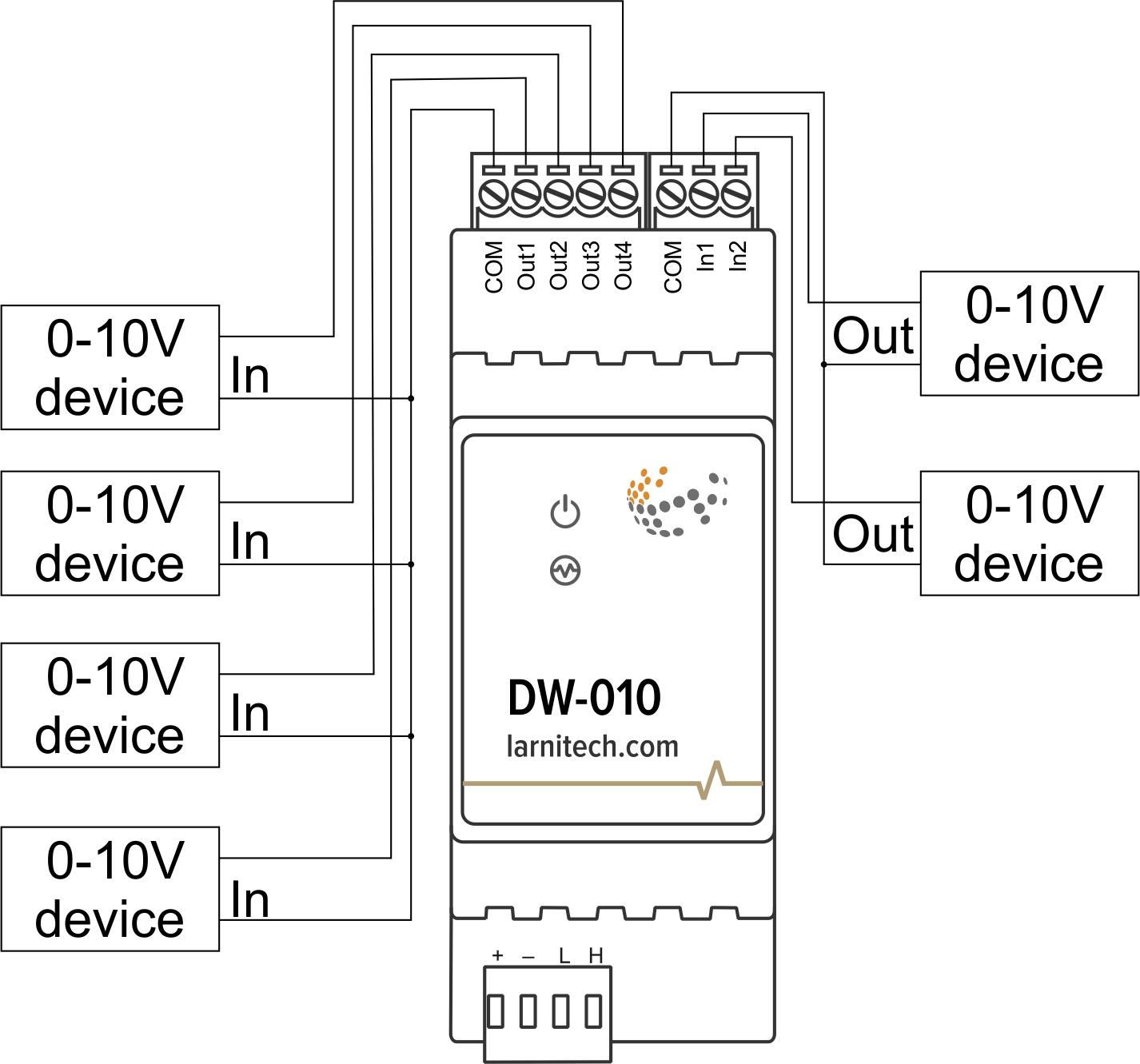Difference between revisions of "DW-010"
Jump to navigation
Jump to search
(Marked this version for translation) |
|||
| (3 intermediate revisions by 2 users not shown) | |||
| Line 1: | Line 1: | ||
| + | <languages/> | ||
| + | <translate> | ||
| + | <!--T:1--> | ||
{{RevisionChanger | hasA = 1 | hasC = 1}} | {{RevisionChanger | hasA = 1 | hasC = 1}} | ||
{{Infobox module | {{Infobox module | ||
| Line 16: | Line 19: | ||
}} | }} | ||
| − | ==MODULE FOR DEVICES WITH 0-10V INPUT OR OUTPUT== | + | ==MODULE FOR DEVICES WITH 0-10V INPUT OR OUTPUT== <!--T:2--> |
| − | This module allows connecting devices with 0-10V | + | <!--T:3--> |
| + | This module allows connecting devices with 0-10V inputs and outputs to the Smart Home system | ||
| − | ==Features== | + | ==Features== <!--T:4--> |
| − | * | + | *4x0-10V outputs |
| − | * | + | *2x0-10V inputs |
| + | <!--T:5--> | ||
<div class="caution"> | <div class="caution"> | ||
CAUTION! All work related to the installation, connection, setting up, service and support must be carried out by qualified personnel with sufficient skills and experience in working with electrical equipment. | CAUTION! All work related to the installation, connection, setting up, service and support must be carried out by qualified personnel with sufficient skills and experience in working with electrical equipment. | ||
| Line 40: | Line 45: | ||
</div> | </div> | ||
| − | ==Overview== | + | ==Overview== <!--T:6--> |
| + | <!--T:7--> | ||
[[File:010C VIEW.png|300px]] | [[File:010C VIEW.png|300px]] | ||
| − | ==Module dimensions== | + | ==Module dimensions== <!--T:8--> |
| + | <!--T:9--> | ||
[[File:010C DIM.png|500px]] | [[File:010C DIM.png|500px]] | ||
| − | ==Connection of 6 0-10V devices== | + | ==Connection of 6 0-10V devices== <!--T:10--> |
| + | <!--T:11--> | ||
[[File:010C EXA.png|500px]] | [[File:010C EXA.png|500px]] | ||
| − | ==Module parameters== | + | ==Module parameters== <!--T:12--> |
| + | <!--T:13--> | ||
{{ Mp | {{ Mp | ||
| inqty = 2 | | inqty = 2 | ||
| Line 70: | Line 79: | ||
}} | }} | ||
| − | ==Indication of module operation== | + | ==Indication of module operation== <!--T:14--> |
===Bootloader=== | ===Bootloader=== | ||
{{indication| textBBB= Waiting for bootloader command}} | {{indication| textBBB= Waiting for bootloader command}} | ||
| Line 81: | Line 90: | ||
}} | }} | ||
| − | ==Module installation and connection procedure== | + | ==Module installation and connection procedure== <!--T:15--> |
#Install the module in the switchboard on the DIN rail and fix it with the special latch on the module base. | #Install the module in the switchboard on the DIN rail and fix it with the special latch on the module base. | ||
#Connect the input/output connectors. | #Connect the input/output connectors. | ||
| Line 88: | Line 97: | ||
#Check all equipment for proper operation. | #Check all equipment for proper operation. | ||
| − | ==Module shut-off and deinstallation procedure== | + | ==Module shut-off and deinstallation procedure== <!--T:16--> |
#Disconnect the CAN connector. | #Disconnect the CAN connector. | ||
#Disconnect the input/output connectors. | #Disconnect the input/output connectors. | ||
#Remove the module from the DIN rail, releasing the latch at the bottom of the module base. | #Remove the module from the DIN rail, releasing the latch at the bottom of the module base. | ||
| − | ==HW settings== | + | ==HW settings== <!--T:17--> |
{|class="wikitable" | {|class="wikitable" | ||
|- | |- | ||
| Line 130: | Line 139: | ||
<item addr="416:98" cfgid="144" logic-ver="19" name="Temperature" system="yes" type="temperature-sensor"/> | <item addr="416:98" cfgid="144" logic-ver="19" name="Temperature" system="yes" type="temperature-sensor"/> | ||
</syntaxhighlight> | </syntaxhighlight> | ||
| + | </translate> | ||
Latest revision as of 13:39, 7 January 2022
| DW-010.C | |||||||
|---|---|---|---|---|---|---|---|
 | |||||||
| |||||||
| |||||||
| |||||||
MODULE FOR DEVICES WITH 0-10V INPUT OR OUTPUT
This module allows connecting devices with 0-10V inputs and outputs to the Smart Home system
Features
- 4x0-10V outputs
- 2x0-10V inputs
CAUTION! All work related to the installation, connection, setting up, service and support must be carried out by qualified personnel with sufficient skills and experience in working with electrical equipment. To avoid the risk of fire, electric shock, damage to the system and/or personal injury, the system installation and assembly must be performed in accordance with the instructions listed below:
- all connectivity work must be carried out with the power turned OFF;
- use appropriate tools and personal protection against electric shock;
- do not use damaged cables, wires and connectors;
- avoid folding the cables and wires;
- do not apply excessive force to the wires by kinking or pressing them too hard: the inner conductors of the cables and wires may get stripped or damaged;
- do not use the power socket with poor contacts to connect;
- do not exceed the load limit parameters specified in the manual;
- the supply conductors wire section is subject to the specifications for current density limit, insulation type and wire material. Light section can result in cable overheating and fire.
When the power is on, NEVER:
- connect/disconnect the connectors;
- open modules and sensors.
Overview

Module dimensions

Connection of 6 0-10V devices

Module parameters
| Parameter name | Value |
|---|---|
| Input channels qty | 2 |
| Output channels qty | 4 |
| Max load per channel | 15mA |
| Power supply | 11.5 … 27.5 V DC from CAN |
| Max current(24V) | 50 mA |
| Push-button/reed switches line recommended length | 30m |
| Bus type | CAN (4-wire) |
| Equipment installation type | DIN rail (EN 60715) |
| Case material | ABS |
| Protection | IP40 |
| Temperature range | -10 … +50 °C |
| Size | 2U, 36x97x58 mm |
| Weight | 130g |
Indication of module operation
Bootloader
| Indicator | Status | Description |
|---|---|---|
| Device in bootloader | ||
| Downloading firmware | ||
| Flashing firmware |
Firmware
| Indicator | Status | Description |
|---|---|---|
| Identification | ||
| Operational mode | ||
Error | ||
| Lost connection to server | ||
| Overheat |
Module installation and connection procedure
- Install the module in the switchboard on the DIN rail and fix it with the special latch on the module base.
- Connect the input/output connectors.
- Connect the CAN connector.
- Configure the module using LT setup.
- Check all equipment for proper operation.
Module shut-off and deinstallation procedure
- Disconnect the CAN connector.
- Disconnect the input/output connectors.
- Remove the module from the DIN rail, releasing the latch at the bottom of the module base.
HW settings
| Name | Type, range | SUBID | Default | Description |
|---|---|---|---|---|
| def | integer 0-250 | 1-4 | 100 | The default brightness level in case of a power reset (1..250). Example: def=250 |
| min | integer 0-100 | 1-4 | 0 | Minimum dimming level, example: min=10 |
| max | integer 0-100 | 1-4 | 100 | Maximum dimming level, example max=95 |
| start | integer 0-100 | 1-4 | 0 | The Start function is used for lamps that lack the minimal voltage to get turned on. If the set value is lower than the start value, the lamp is turned on at the start value and them the light is dimmed down to the set level. Example: start=60 |
| force | integer 0-100 | 1-4 | 10 | Time duration of the starting value (measured in milliseconds). Example: force=20 |
| runtime | integer 0-60000 | 1-4 | 1000 | Runtime is the speed of changing the brightness from ‘min’ to ‘max’ (measured in milliseconds). Example: runtime=1000 |
| dm | char[4] | 98 | 'vvvv' | Each char is responsible for the type of a particular channel
Example: dm='skl-' |
1<item addr="416:1" auto-period="600" cfgid="144" name="Dimmer 1" type="dimmer-lamp"/>
2<item addr="416:2" auto-period="600" cfgid="144" name="Dimmer 2" type="dimmer-lamp"/>
3<item addr="416:3" auto-period="600" cfgid="144" name="Dimmer 3" type="dimmer-lamp"/>
4<item addr="416:4" auto-period="600" cfgid="144" name="Dimmer 4" type="dimmer-lamp"/>
5<item addr="416:31" cfgid="144" name="Voltage" system="yes" type="voltage-sensor"/>
6<item addr="416:32" cfgid="144" name="Voltage" system="yes" type="voltage-sensor"/>
7<item addr="416:97" cfgid="144" name="Temperature" system="yes" type="temperature-sensor"/>
8<item addr="416:98" cfgid="144" logic-ver="19" name="Temperature" system="yes" type="temperature-sensor"/>